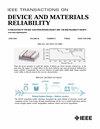大电流脉冲晶闸管开关电侵蚀加速失效机理研究
IF 2.3
3区 工程技术
Q2 ENGINEERING, ELECTRICAL & ELECTRONIC
IEEE Transactions on Device and Materials Reliability
Pub Date : 2025-04-29
DOI:10.1109/TDMR.2025.3565618
引用次数: 0
摘要
基于脉冲晶闸管的大电流开关在大电流脉冲条件下工作,并受到电磁-热-机械耦合应力的影响,导致热疲劳失效机制的逐步发展。研究表明,局部过热会引发铝层的电侵蚀,从而进一步加速大电流开关的热疲劳失效。为了研究这一现象,研究人员建立了一个考虑表面粗糙度影响的硅-铝界面微观模型,以量化不同脉冲电流条件下的瞬态温升和电侵蚀阈值,实验验证表明了很强的一致性。此外,利用热网络模型,我们建立了不同大电流脉冲和夹紧应力下电侵蚀阈值与平均结温之间的相关性,从而定义了大电流脉冲晶闸管开关的电侵蚀工作范围。这为这些开关的可靠运行提供了理论指导。本文章由计算机程序翻译,如有差异,请以英文原文为准。
Research on the Mechanism of Electrical Erosion Accelerating Failure in High-Current Pulse Thyristor-Based Switches
High-current pulse thyristor-based switches operate under high-current pulse conditions and are subjected to coupled electromagnetic-thermomechanical stresses, resulting in the progressive development of thermal fatigue-induced failure mechanisms. The study revealed that localized overheating triggers electrical erosion of the aluminum layer, which further accelerates the thermal fatigue failure of high-current switches. To investigate this phenomenon, a microscopic model of the silicon-aluminum interface incorporating surface roughness effects was developed to quantify the transient temperature rise and electrical erosion threshold under varying pulsed current conditions, with experimental validation demonstrating strong agreement. Furthermore, using a thermal network model, we established a correlation between the electrical erosion threshold and the average junction temperature for different high-current pulses and clamping stresses, thereby defining the operational range for electrical erosion in high-current pulse thyristor-based switches. This provides theoretical guidance for the reliable operation of these switches.
求助全文
通过发布文献求助,成功后即可免费获取论文全文。
去求助
来源期刊

IEEE Transactions on Device and Materials Reliability
工程技术-工程:电子与电气
CiteScore
4.80
自引率
5.00%
发文量
71
审稿时长
6-12 weeks
期刊介绍:
The scope of the publication includes, but is not limited to Reliability of: Devices, Materials, Processes, Interfaces, Integrated Microsystems (including MEMS & Sensors), Transistors, Technology (CMOS, BiCMOS, etc.), Integrated Circuits (IC, SSI, MSI, LSI, ULSI, ELSI, etc.), Thin Film Transistor Applications. The measurement and understanding of the reliability of such entities at each phase, from the concept stage through research and development and into manufacturing scale-up, provides the overall database on the reliability of the devices, materials, processes, package and other necessities for the successful introduction of a product to market. This reliability database is the foundation for a quality product, which meets customer expectation. A product so developed has high reliability. High quality will be achieved because product weaknesses will have been found (root cause analysis) and designed out of the final product. This process of ever increasing reliability and quality will result in a superior product. In the end, reliability and quality are not one thing; but in a sense everything, which can be or has to be done to guarantee that the product successfully performs in the field under customer conditions. Our goal is to capture these advances. An additional objective is to focus cross fertilized communication in the state of the art of reliability of electronic materials and devices and provide fundamental understanding of basic phenomena that affect reliability. In addition, the publication is a forum for interdisciplinary studies on reliability. An overall goal is to provide leading edge/state of the art information, which is critically relevant to the creation of reliable products.
 求助内容:
求助内容: 应助结果提醒方式:
应助结果提醒方式:


